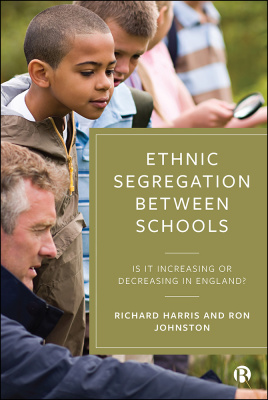By Rich Harris

It is now a little over 18 months since the publication of my most recent, co-authored book, Ethnic Segregation Between Schools: Is It Increasing or Decreasing in England? (Bristol University Press).
The book was written in direct response to the 2016 Casey Review and to the notion, sometimes found in Government-backed policy documents and reinforced by the media, that ethnic segregation is growing in England. It isn’t. Whilst high levels of ethnic segregation do exist between the majority White British and some other groups such as the Bangladeshi and Pakistani – more so at the primary than secondary level of schooling and increased also for the more affluent of the White British – the general trend is towards desegregation and greater ethnic diversity within local authorities and their schools. Key findings of the book include:
- The decrease in the percentage of schools in which the White British predominate, albeit that the White British remain the majority or the largest group (but less so than in the past).
- Places where the White British are least prevalent (accounting for fewer than ten per cent of pupils in more than half of the schools) are all in London – Newham, Brent, Tower Hamlets, Harrow, Haringey, Lambeth, Redbridge and Ealing – though such schools are also reasonably common in Slough, Birmingham, Leicester, Luton, Bradford, Blackburn, Manchester and Oldham (as well as other parts of London).
- Although members of minority groups are, on average, in schools where minority groups form a majority, the White British remains as the group that members of minority groups are most likely to encounter in their schools.
- With regard to primary schools, the Bangladeshi and Pakistani are the two groups more likely to be in schools where the White British form a very low percentage of pupils.
- The White British are overwhelmingly in primary schools where theirs is the largest group and typically also the majority. It is very rare for a White British pupil to be in a school where the percentage of White British pupils is very low.
- Around half or more of pupils in most ethnic groups are in secondary schools where the White British are the largest group. The Bangladeshi and Pakistani groups are an exception to this (and, very marginally so, Black Caribbeans).
- It is not typical for a pupil to be in a school where their own ethnic group is the largest group, except for the White British, and for Pakistanis in primary schools.
- Although schools with very high percentages of any one minority group do exist, they are extremely rare, becoming rarer.
- On average, secondary schools are more diverse than primary schools but both are diversifying.
Sadly, the publication was the last that I wrote with my co-author, Ron Johnston. Ron was an exceptional scholar, a giant of the discipline and foundational to the longevity and growth of the Quantitative Spatial Science Research Group (previously Spatial Modelling Group) at Bristol. Working with him wasn’t always easy – his standards were (rightly) high and demanding, and I sensed a frustration that his health at the time wasn’t allowing him to participate as fully to the project as I suspect he would have liked – but his influence on shaping the book was high. His influence on shaping me as an academic, over a longer period of time, was even greater and hugely appreciated as he was always generous with him time, expertise and wisdom.
As we approach the release of the 2021 Census data there will be opportunity again to revisit the topic of segregation, and where and if it is happening. My prediction? That the trend towards desegregation and greater population mixing will have continued, hampered only not by ethnic segregation but between social segregation and the inequalities between the rich and poor, shaping who can afford to live where. In other words, ethnic segregation will have lessened but will persist until underlying causes, such as inequalities in the labour markets, are more fully tackled.
Ron Johnston’s obituary in The Guardian can be viewed here.

